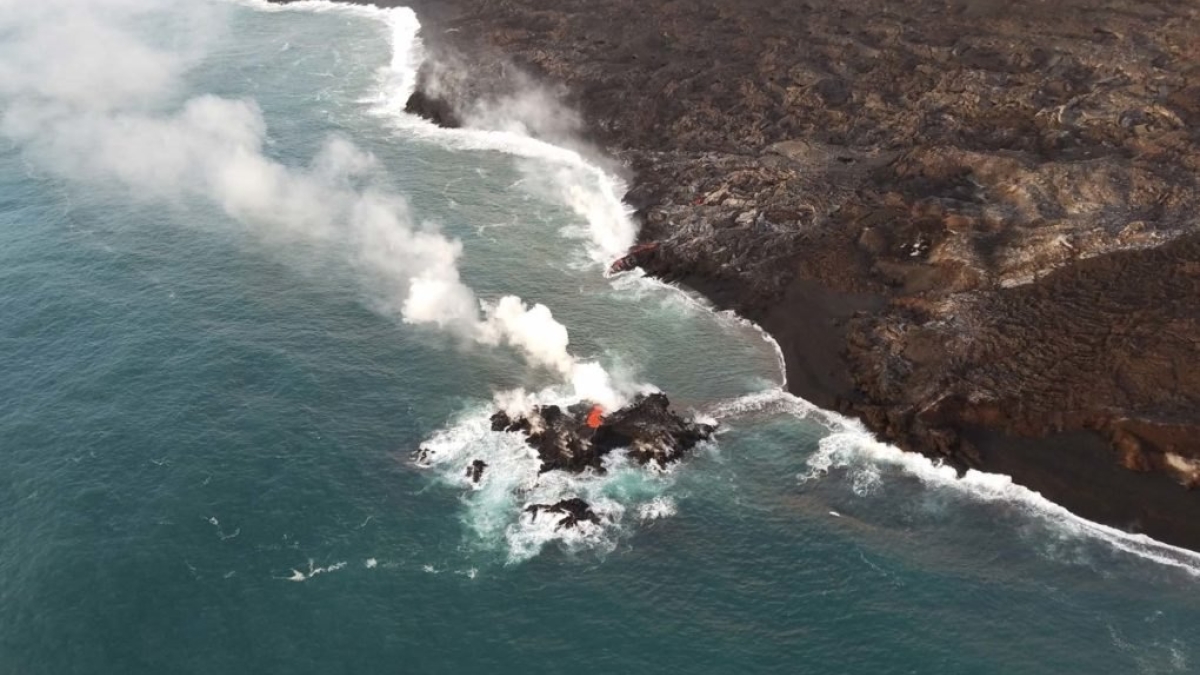Most natural disasters drop off the news after a few days. Producers and editors have a sixth sense for knowing when viewers and readers have had enough walls of flame, floating cars or flattened houses.
But the spectacle of an erupting volcano vomiting streams of molten rock across a suburb and into the sea proved irresistible all summer long. The eruption of Kilauea on the big island of Hawaii brought lava coursing across roads, refrigerator-size rocks flying into the air, and homes burning furiously while correspondents stood feet away. It was compelling stuff.
Kilauea is a volcano that can vogue, and a little more than a week ago it revealed it wasn’t done yet.
A new island was born in the sea a few yards from the mainland. About 20 by 30 feet (around 600 square feet, a small studio apartment), it immediately raised silly questions. Can I live on it? Who owns it?
We talked to David Williams, an associate research professor in Arizona State University’s School of Earth and Space Exploration. Williams studies volcanology and planetary geology, and every few years teaches a class on planetary volcanology. Williams talked about the danger, the fact that Kilauea has been erupting since the year before Madonna’s “Like A Virgin” album came out, and the real island that will someday rise from the sea to become part of the Hawaiian archipelago.
Question: Is Kilauea still erupting?
Answer: Kilauea started erupting in January of 1983. This thing that started back in May, this eruption that came out of the Leilani Estates and destroyed all those houses and created a new lava field and channels that’s leading to this island here, there might be temporary pauses in some locations but there could be movement in the volcanic plumbing system underneath the volcano. The Big Island of Hawaii is actually composed of five separate volcanos. Kilauea, which is active right now, and Mauna Loa, which is not active at the moment but it has been, are still places where obviously stuff can happen. The other three volcanos haven’t been active in recent times.
Q: How did the island form?
A: What this island is, is you have hot basaltic lava that’s typical of what erupts on Hawaii and it’s being carried in lava channels and lava tubes from a source there. It flows down towards the sea and sometimes it’ll erupt underground or underwater. It’ll be like a submarine. It’ll flow underwater and you’ll have this crust will form that will insulate the lava so it’s still warm. Eventully if the pressure is great enough it will push this lava up and it’ll break the surface. That’s what this small island — 20 by 30 feet or whatever it is — is. It’s a place where magma from the main flow erupted underwater and just built up this small island.
Q: There’s another island in the making?
A: Eventually a whole separate island coming up from the ocean floor will happen later in time. It’s called Loihi. It’s forming in the ocean to the southwest of the Big Island. Eventually it will become the next major Hawaiian island. The idea is that the Pacific plate is moving over the surface of a hot spot, and that hot spot produces this chain of islands. If you look on a globe and see the whole Hawaiian island chain, then there’s a break and another whole chain of volcanic islands from when the plate changed direction. This is a manifestation of plate tectonics and volcanism on Earth that’s been going on in the entire planet’s history.
Q: Is the new island habitable?
A: It’s a very, very small spot of hot lava which is cooling. Probably over a period of months maybe if it’s cooled enough and getting some fresh water, then maybe plants will grow on it.
Q: Who owns it?
A: It’s part of Hawaii. If this island came up and it’s part of the chain, and it’s close enough to Hawaii, I would assume it remains part of the state of Hawaii and part of the United States.
Q: We learned this summer that lava insurance doesn’t exist. Is there anything that can be done if you live beside a volcano?
A: People have tried all sorts of things, like squirting water on the hot lava to freeze it so that it won’t advance. None of those techniques work really well. You’re sort of at the mercy when you build your houses close to an active volcano. It’s one thing for these slow-moving lava flows in Hawaii, but if you were on a big stratovolcano like Mount St. Helen’s or Mount Fuji in Japan or Vesuvius in Italy, and you have one of those eruptions that produce those hot pyroclastic flows, that’s total mayhem. You’re not going to be able to outrun those things.
Top photo: The new baby island, courtesy of the Hawaii Volcano Observatory, United States Geological Survey.
Editor’s note: As of press time, the island became connected to the main flow by a strip of lava. Geologists predict it will be washed away by the Pacific once the lava flow stops.
More Science and technology

The science behind chronic stress
Stress comes in many shapes and sizes. There’s the everyday stress of preparing for a final exam or being stuck in traffic. And the more significant stress of losing a friend, family member,…

ASU planetary scientist to be inducted into the National Academy of Sciences
The National Academy of Sciences is inducting School of Earth and Space Exploration Director Meenakshi Wadhwa into the 2023 class of new members for her pioneering work in planetary sciences and…

Unlocking the potential of AI for homeland security
“Can we do what we're doing now cheaper, more efficiently, more effectively?” Adam Cox, director in the Office of Strategy and Policy at the Department of Homeland Security Science and Technology…
